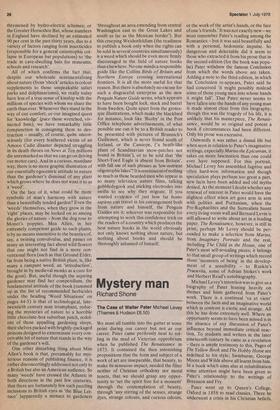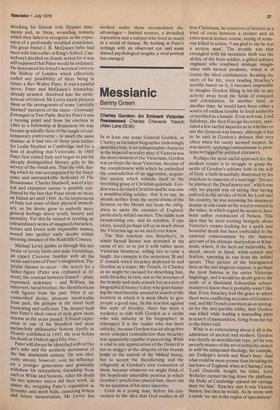Mystery man
Richard Shone
The Case of Walter Pater Michael Levey (Thames & Hudson £8.50) We must all tumble into the gutter at some point during our career but not as our career. Pater came perilously near to rolling in the mud of Victorian opprobrium when he published The Renaissance in 1873. It contained the then astonishing propositions that the form and subject of a work of art are inseparable, that beauty, to make its sensuous impact, needed the filter neither of Christian orthodoxy nor moral tenets, that we should grasp any opportunity to 'set the spirit free for a moment' through the contemplation of beauty, through 'any stirring of the senses, strange dyes, strange colours, and curious odours, or the work of the artist's hands, or the face of one's friends.' It was not exactly new —we must remember Pater's reading among the Romantics — but it was said beautifully and with a personal, hedonistic impulse. So dangerous and delectable did it seem to those who extracted it from his prose that in the second edition (for the book was popular) Pater withdrew the famous Conclusion from which the words above are taken. Adding a note to the third edition, in which the Conclusion re-appears, Pater said he had conceived it might possibly mislead some of those young men into whose hands it might fall'. That Pater never seems to have fallen into the hands of any young man is made almost clear from this biography; though this was the tragedy of his life, it is unlikely that his masterpiece, The Renaissance, would be so original and potent a book if circumstances had been different. Only his prose was excessive.
Outwardly it was rather a dismal life but when seen in relation to Pater's imaginative writings, expecially Marius the Epicurean, it takes on more fascination than one could ever have supposed. For this portrait, Michael Levey has assembled fugitive and often hard-won information and though speculation plays perhaps too great a part, new facts have been added and old myths denied. At the moment! doubt whether any renewal of interest in Pater would have the slightest effect when art goes arm in arm with politics and Puritanism, when the Pre-Raphaelites and the Surrealists haunt every living-room wall and Bernard Levin is still allowed to write about art in a leading paper. The Renaissance, however, is still in print; perhaps Mr Levey should be per. suaded to make a selection from Marius, from Imaginary Portraits and the rest, including The Child in the House, one of Pater's most self-revealing pieces; it belongs to that small group of writings which record those 'moments of being' in the development of a sensibility — to Ruskin's Praeterita, some of Adrian Stokes's work and Herbert Read's autobiography.
Michael Levey's intention was to give us a biography of Pater leaning heavily on themes and hints gathered from Pater's work. There is a continual `va et vient' between the facts and an imaginative world which in contrast is exotic and strange. All this he has done extremely well. Where an opportunity seems to have been missed is in the absence of any discussion of Pater's influence beyond immediate critical reaction. To students and writers in the later nineteenth century he came as a revelation — there is ample testimony to this. Pages of The Yellow Book and The Hobby Horse are indebted to his style; Swinburne, George Moore and Wilde above all learnt from him. In a book which aims also at rehabilitation some attention might have been given to Pater's relationship to the writings of Berenson and Fry.
Pater went up to Queen's College, Oxford in 1858 to read classics. There he underwent a crisis in his Christian beliefs, shocking his friends with flippant statements and, to them, wounding remarks which they failed to recognize as the expression of a profoundly troubled conscience. His great friend J. R. McQueen (who had been with him earlier at King's School, Canterbury) decided on drastic action for it was still supposed that Pater would be ordained. He denounced his friend's heretical views to the Bishop of London which effectively ended any possiblility of there being in future a Rev Walter Pater. It was a painful move; Pater and McQueen's friendship, already strained, dissolved into the strifetorn air of Oxford. Mr Levey nicely pictures them as the protagonists of some 'carefully finished' narrative of the times — Comrades Estranged or Two Paths. But for Pater it was a turning point and from his election in 1864 to a fellowship at Brasenose his way became gradually clear of the tangle of contemporary controversy 7 in much the same manner as it had two or three year earlier for Leslie Stephen at Cambridge and for a host of doubting mid-Victorians. In 1865 Pater first visited Italy and began to put his already distinguished literary gifts to the service of the visual arts. That the visit, during which he was accompanied by the handsome and unremarkable dedicatee of The Renaissance, Charles Shadwell, was of a lyrical and expansive nature is possibly confirmed by the fact that Pater wrote no more on Italian art until 1890. As his impressions of Italy lost some of their physical immediacy, so his desire grew to embody more general feelings about youth, beauty and mortality. For this he turned to creating an extraordinary series of imagined characters, heroes and lovers with impossible names, wooed into perfect early deaths within shouting distance of the Radcliffe Camera.
Michael Levey guides us through this hothouse of lovely limbs and male friendships, an expert Cicerone familiar with all the twists and turns of Pater's imagination. Particular themes re-occur — the search for a father-figure (Pater was orphaned at fifteen), the contrast between himself — plain, repressed, sedentary — and William, his extrovert, naval brother, the identifications with figures from the past. Here is circumscribed desire, pleasure inextricable from pain, the glimpse in the street both frustrating and sufficient. The despair built Into Pater's ideal vision of style grew more intense as the years passed. It found expression in one of his bloodiest and most melancholy philosophic fictions Apollo in Picardy published in 1893, the year before his death at Oxford aged fifty-five. Pater will always be identified with art for art's sake and the aesthetic movement of the late nineteenth century. He was obviously uneasy, however, over his influence On a younger generation and gradually Withdrew his sympathetic friendship from such as Wilde and Symons. After his death h!s two spinster sisters did their work, as sisters do, wrapping Pater's reputation in lavender and moth balls, censoring letters and future memorialists. Mr Levey has worked under these accumulated disadvantages — limited sources, a dwindled reputation and a subject who lived so much in a world of fantasy. By looking at Pater's writings with an observant eye and some shrewd psychological insights, a vivid portrait has emerged.







































 Previous page
Previous page